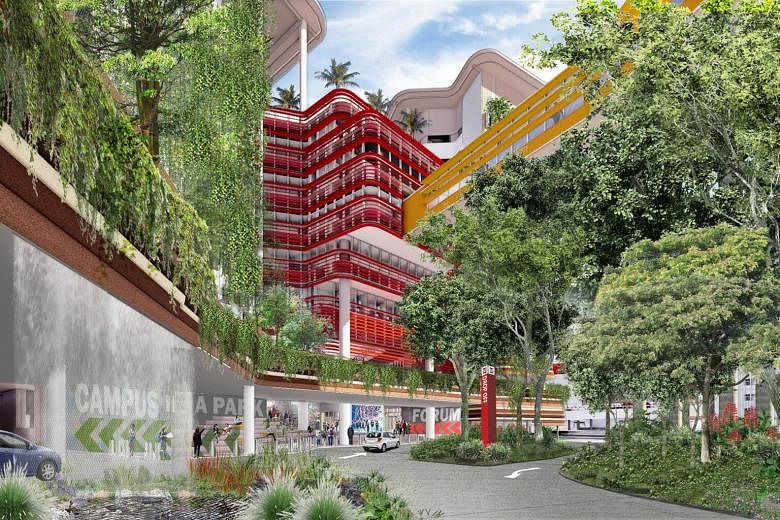SINGAPORE - The new campus of the Singapore Institute of Technology (SIT), to be built by 2023 in the heart of the Punggol Digital District, will be integrated with industry and the community in the north-east region of Singapore, further strengthening its unique industry-focused, applied-learning model.
When completed, the 91,000 sq m campus, on two plots of land about the size of 17 football fields, will be able to accommodate 12,000 students. This is far more than the 8,000 students in the university's distributed campuses in the five polytechnics and Dover Road currently.
The university will be co-located with JTC Corporation's business park buildings in the Punggol Digital District, enabling students, faculty and industry professionals to work together on projects.
For example, new ideas conceived in SIT could be tested in the district, enabling them to go to market faster. In addition, companies can tap SIT's applied learning and research capabilities, as well as its talent pool in areas such as cyber security, engineering, food technology, assistive technology, allied health and hospitality.
The campus will also be a people's university as the public will be able to access many of the spaces on the ground level, including the park, which conserves the forest along Punggol Road, the market village, and the foodcourt facing the waterfront.
Prime Minister Lee Hsien Loong, who was at the ground-breaking ceremony of the campus on Tuesday (Sept 10), said that what sets SIT apart from the other five autonomous universities is the greater emphasis on practice-oriented learning.
He referred to SIT's origins in the Polytechnic-Foreign Specialised Institutions scheme 14 years ago, where polytechnics partnered with a small group of overseas universities to offer niche degree programmes for their graduates.

After running the programme for about four years, the Education Ministry decided to set up SIT in 2010 to bring all the degree programmes under one university.
Today, as an autonomous university, SIT runs 42 degree programmes and awards degrees in its own name. Its enrolment has grown from 500 students in 2010 to 8,000 now.
PM Lee noted the healthy 90 per cent job rate for SIT graduates and said: "SIT's model balances meeting students' degree aspirations, while ensuring they are sought after by the industry."
He said now that SIT has operated for a decade and become a university in its own right, it is only natural to make the next move to a single, consolidated campus.
He said the new campus in the Punggol Digital District will strengthen the strong nexus that SIT already has with the industry.
"We hope to support an ecosystem for digital and tech companies here, to trial new concepts to work, study and live, before scaling them up nationally. By being co-located here, SIT faculty and students can come together with industry professionals to collaborate on projects, and support test-bedding opportunities," he said.
He also referred to SIT's many efforts to connect with the communities in Punggol, including running science camps for schools, and added: "You will be a big part of the Punggol community in the future, and I hope you can embrace this identity and have your students do their part for the people here."
Among the state-of-the art features of the new campus will be a smart network of more than 10,000 sensors that will collect temperature, ambient light and human presence data. The data will be continuously analysed and adjustments made to enhance workspace efficiency.
It will also be the first university in South-east Asia to have a multi-energy micro-grid network, which will draw energy from various sources. The system could help SIT save energy and eliminate carbon emissions, equivalent to removing close to 2,000 vehicles from the roads.
SIT president Tan Thiam Soon said that SIT, which took in 2,700 students in the new academic year that started this month, will have an annual intake of more than 3,000 undergraduates when the new campus opens in 2023. He said that SIT, which was established in 2009, has played a key role in meeting the Government's target of raising the university participation rate to 40 per cent by 2020.
He added that SIT is fortunate to have the strong support of the Government to build a campus at this point in time, when technology is beginning to have a huge impact on how students learn.

He said: "We have the opportunity to build a campus that is approachable and aspirational, fostering a vibrant environment that is both inviting and inspiring while leveraging the technology that is available to us.
"It is a rare opportunity to reimagine what a university campus, a university environment of the future, will be and work towards realising it."
Mr Ng Yat Chung, chairman of the SIT board of trustees, said: "We have made good progress in our journey towards a university of applied learning and I look forward to the many exciting opportunities before us in the next phase of SIT's journey."












